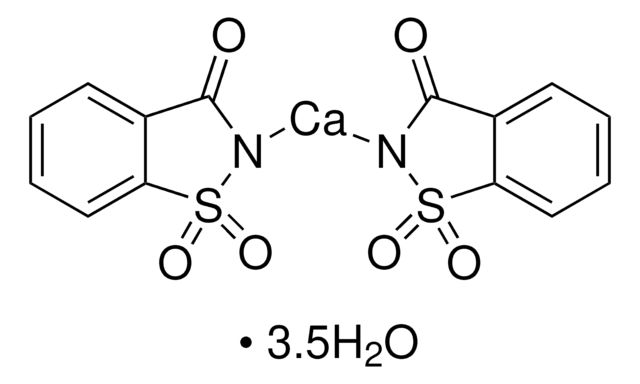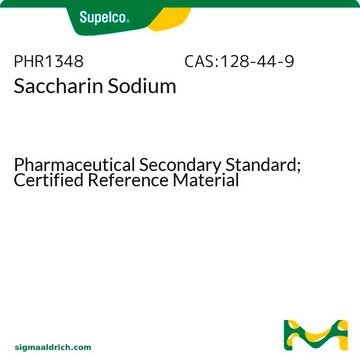240931
Saccharin
≥99%
Synonyme(s) :
2,3-Dihydroxy-1,2-benzisothiazol-3-one-1,1-dioxide, 2-Sulfobenzoic acid imide, o-Benzoic sulfimide
About This Item
Produits recommandés
Pureté
≥99%
Forme
powder
Pf
226-229 °C (lit.)
Solubilité
acetone: 1g in 12mL(lit.)
alcohol: 1g in 31mL(lit.)
boiling water: 1g in 25mL(lit.)
water: 1g in 25mL(lit.)
Chaîne SMILES
O=C1NS(=O)(=O)c2ccccc12
InChI
1S/C7H5NO3S/c9-7-5-3-1-2-4-6(5)12(10,11)8-7/h1-4H,(H,8,9)
Clé InChI
CVHZOJJKTDOEJC-UHFFFAOYSA-N
Vous recherchez des produits similaires ? Visite Guide de comparaison des produits
Description générale
Application
- Gabapentin-saccharin co-crystals with enhanced physicochemical properties and in vivo absorption formulated as oro-dispersible tablets.: This study presents the formulation of gabapentin-saccharin co-crystals, demonstrating improved solubility and absorption, beneficial for pharmaceutical applications (Soliman et al., 2020, doi: 10.1080/10837450.2019.1687521).
- Improving the solubility, dissolution, and bioavailability of Ibrutinib by preparing it in a coamorphous state with saccharin.: The research focuses on enhancing the bioavailability of Ibrutinib through coamorphous preparation with saccharin, which is significant for cancer treatment (Shi et al., 2019, doi: 10.1016/j.xphs.2019.04.031).
Actions biochimiques/physiologiques
Code de la classe de stockage
11 - Combustible Solids
Classe de danger pour l'eau (WGK)
WGK 2
Point d'éclair (°F)
Not applicable
Point d'éclair (°C)
Not applicable
Équipement de protection individuelle
Eyeshields, Gloves, type N95 (US)
Certificats d'analyse (COA)
Recherchez un Certificats d'analyse (COA) en saisissant le numéro de lot du produit. Les numéros de lot figurent sur l'étiquette du produit après les mots "Lot" ou "Batch".
Déjà en possession de ce produit ?
Retrouvez la documentation relative aux produits que vous avez récemment achetés dans la Bibliothèque de documents.
Les clients ont également consulté
Notre équipe de scientifiques dispose d'une expérience dans tous les secteurs de la recherche, notamment en sciences de la vie, science des matériaux, synthèse chimique, chromatographie, analyse et dans de nombreux autres domaines..
Contacter notre Service technique









